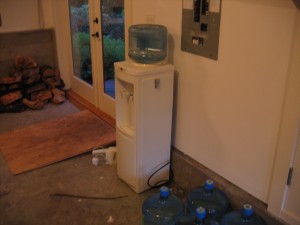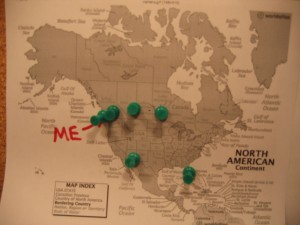Contrary to my predictions in my last post, my lunch on Wednesday was actually more local in its ingredients. I unfroze some chili I had made a week ago, and ate that with some couscous. Ill do my best to outline all of the ingredients in the chili:
Prepackaged mix
The pre-packaged mix includes raw beans, chili spices and some dried chives for extra flavor. It is packaged by a company called Mitchell’s Soup Company, which to my delight hand makes all of their products from the Cowichan Valley on Vancouver Island! I have finallycome across a food product thatdoes not have to cross water to get to the supermarket. It is roughly 140 km from the valley, to Thrifty Foods, to my house, so in a truck that would burn roughly 54.6 litres of gas to transport.
The pre-packaged recipe calls for 3 extra ingredients: tomatoes, an onion and some ground beef. The tomatoes are from Abbostsford BC, which I was thrilled to hear because it’s the first ingredient I’ve blogged about to be within 100 miles of my home! However, it just barely makes it at around 94 miles. It was also grown in a greenhouse, which although makes use of solar energy to heat itself through convection, still has to be heated significantly using fossil fuels in colder climates.
The onions are grown in the USA. Washington is the second largest state in the US for onion production, as well as being the closest state to BC, so initially I guessed that this is where the onion is from. However, according to the National Onion Association (of the United States), spring and summer onions are more likely to come from Arizona, which is roughly 2,800 km away[1]. To my surprise, despite not having the handling restrictions of dairy products, onions go through a similar inspection process to that of eggs. Both are inspected, graded, packaged, and usually required to be kept cool or frozen for storage in cooler months.
As for the meat, I tried to avoid ground beef and choose a non-ruminating animal as a substitute, namely ground turkey. The turkey was grown organically also in the Cowichan Valley, which means that there are considerably lower fossil fuel inputs into their feed. The turkey must still be processed and its meat ground and packaged to ultimately be transported to stores, which may possibly use oil as a fuel and plastics input to carry these steps out.
The couscous was prepared in Delta, BC and is also organic, which greatly surprised me as well because I have eaten this brand of couscous before many times and never knew it was organic. It was only after scouring the box for the area in which it was grown that I found in tiny writing on the bottom of the box “Certified Organic by the Organic Crop Improvement Association”. I was perplexed as to why the company would not want to advertise this more transparently to their consumers, especially if they had gone through the trouble to get it certified by an official organization. The Box is 100% recycled paper, which saves some oil in not having to construct new paper but is still a very oil and water intensive project due to the recycling.
My last ingredient that I thought I should touch on is the water I was drinking. Victoria sits almost directly on the Juan de Fuca fault line, which means that we are very susceptible to earthquakes. The area is in fact “due” for the next big one, which could come tomorrow or in 100 years from now. The situation gets worse when the fact that 95% of Vancouver islands food is imported from the mainland[2] is considered, which brings up serious food security issues if we were ever cut off from the mainland for a short period of time for any reason. As a result, our family stays stocked with a lot of canned goods that we eat and restock but keep in large supply, as well as having an emergency water cooler. These water jugs are kept in a tick plastic container and can become unsafe to drink if they are stored for too long.
As a result, despite having clean and fresh tap water, we usually drink from the cooler which uses much more oil to package and transport. I thought this is an interesting example of how our entire family, including myself, is not willing to put an environmental concern above what we feel is our personal safety insurance. However the water is tapped from Fanny Bay, BC and is bottled in Richmond, BC, so at least the entire production process is spread over less than a 300km distance.
*just to clarify the water I used to cook the chili in was from the tap. I still end up using the tap a lot!
Here is the update on my north american map of food origin. Florida still holds the infamous position for longest transportation:



